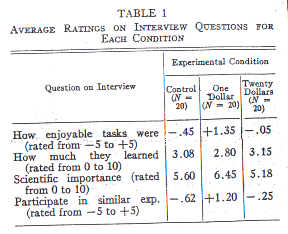Festinger and Carlsmith
Cognitive consequences of forced compliance
In Festinger and Carlsmith's classic 1956 study, undergraduate students of Introductory Psychology at Stanford University were asked, during the first week of the course, to take part of a series of experiments.
It was explained that, since students were required to serve in experiments, the Department of Psychology was conducting a study to evaluate these experiments in order to be able to improve them in the future. It was expected that a sample of students would be interviewed after having served as participants in the experiments. Students were urged to cooperate in these interviews by being completely and honest.
Festinger and Carlsmith's study focussed its attention on 71 male students who participated in an experiment allegedly dealing with "Measures of Performance."
On their individual arrival at the building where the experiment was to take place each student experienced a brief stay in the secretary's office and was then conducted to a laboratory area by an experimenter. The experimenter explained that the experiment itself usually took a little over an hour to conduct but was scheduled for two hours giving some people from Introductory Psychology an opportunity to interview some of the participants afterwards.
The 71 students concerned were required to perform repetitive tasks. These tasks, which the researchers intended to seem boring and meaningless, typically consisted of an initial half-hour of putting 12 spools onto a tray, emptying the tray, refilling it with spools, and so on, using one hand only. Then a second half-hour was spent turning 48 square pegs mounted on a board by clockwise quarter-turns. The subject was to again use one hand only, to work at their own pace, and to begin again the process of turning peg 1 when peg 48 had been reached.
Whilst each student was performing these tasks an experimenter was present in the room with a stop watch and a pad upon which notes were made.
At the end of these two tasks the experimenter then 'explained' the background to the experiment to the student. The student was told that he was actually part of a control group who were asked to perform the tasks without much in the way of introduction as to the tasks themselves or as to how enjoyable they were. These was another group of subjects - "Group B", however, who were introduced to the tasks by an associate of the experimenter. This associate was presented to "Group B" students taking part in the experiment as being another student who had just finished his own experimental session. The experimenter portrayed this associate as giving a positive introduction to the experiment relaying a brief outline of the tasks and of presenting them as being enjoyable and interesting to the subjects who were just about to perform tasks themselves.
A sheet of paper headed "For Group B" was shown by the experimenter to the subject which outlined a role this associate was expected to perform in conveying enthusiam for the experimental tasks. The experimenter told the subject that the "Measures of Performance" experiment was looking into the relative performance of those who had been given no introduction to those in Group B who had been given the positive introduction.
All 71 of the students received this same treatment of a short wait in the secretary's office, of performing the two tasks, and then of the 'explanation' being offered about their own role being that of being part of a control group in contradistinction to others who had experienced a positive introduction to the tasks by the experimenter's associate.
Each student was asked to again wait in the secretary's office to see if people from Introductory Psychology did indeed wish to interview him in order to glean information that might help in the better implementation of experimental programs in the future.
Festinger and Carlsmith's study now began to treat the 71 subjects in different ways such as to investigate the cognitive consequences of induced compliance to see whether there would be any evidence of Cognitive Dissonance, where the student concerned was psychologically di-stressed between his actual views and the role he found himself taking on in compliance with the performance of the tasks set by the experimenter.
After a delay of several minutes the experimenter returned to the secretary's office. About a third of subjects were released from the experiment at this point after being thanked by the experimenter, (who also expressed the hope that the subject had enjoyed the experience), and being interviewed by someone from the psychology department ostensibly with the view of improving the presentation of experiments in the future. These were Festinger and Carlsmith's actual 'control' group.
The other two-thirds however went through a procedure where a slightly embarrassed seeming and hesitant experimenter asked them for a favour. A scenario was presented where the experimenter's usual associate had been unable to attend for an upcoming session where a positive introduction to the tasks was to be given to the next subject. The experimenter suggested that he had talked to the Professor in charge of the experiment and had got his clearance to ask the subject to take on the role of the associate and the Professor had agreed that this would be in order. The experimented stressed that acceptance would oblige and might lead to future involvements in experiments if the associate was again unavailable.
Some one half of the remaining students were offered $1 for taking on the associate's role with the understanding that they would be 'on call' for the future, the other half of the remaining subjects were offered $20 for the same services. Any hesitancy on the part of the subject was eroded by further encouragement from the experimenter.
Once the subject did agree the sheet of paper headed "For Group B", and outlining the enthusiastic introduction to the tasks to be given by the associate to Group B subjects, was again shown to the subject who was obliging the experimenter through his co-operation. The fee was paid and a receipt was signed by the subject.
The subject was then told that the experimenter 'thought' that the next "Group B" subject (actually another associate of the experimenter) was female and was waiting to be given the positive introduction to the tasks ahead. The subject was then taken into the secretary's room where he was expected to converse with this "next subject" with the view of attempting to get across the points that he had read on the sheet of paper headed "For Group B."
After a short time the experimenter returned and the subject thought that his role had now ended. The experimenter again brought up the possibility of someone from Introductory Psychology wanting to interview the subject.
It was at this point that the treatment of the three groups of subjects (i.e. control, $1, and $20) again resumed a common course in that as he brought each subject to the office where this interview was to take place the experimeter thanked the subject for his co-operation and expressed the hope that the subject had enjoyed the experience.
At the interviewer's office door the experimenter asked the interviewer whether he wished to interview the subject. A positive answer was given and the experimenter again thanked the subject and left.
The interviewer, who had no way of knowing whether the subject was from the control, $1, or $20 group then interviewed the subject. There were four areas of inquiry through an initial discussion and then with the student being invited to give a rating figure :-
Were the tasks interesting and enjoyable? Rating scale -5 to +5
Did the experiment give the subject an opportunity to learn about their own abilities? Rating scale 0 to 10
Would the subject say that the experiment as he had experienced it was actually likely to measure
anything important? Rating scale 0 to 10.
Would the subject have any desire to participate in another similar experiment? Rating scale -5 to +5
The interview was brought to a close by the interviewer asking the subject about what he thought the experiment was
about and whether he had any suspicions about it. Those in the control group were then allowed to leave whilst
those in the $1 and $20 groups were again brought into the presence of the experimenter, and the female associate,
where the realities of the experiment were fully explained and where they were asked to refund their $1 or $20.
In the event the responses of not all 71 subjects were considered in Festinger and Carlsmith's overall assessment. There were eleven exceptions each of whom had been given the benefit of a full explanation of the actual structure and purposes of the experiment before leaving the premises.
Five of the paid subjects, (three $1 and two $20), were highly suspicious about being paid to tell the girl that the tasks were interesting - this led them to question the actual purpose of the experiment. Two of the paid subjects, (both $1), told the girl that the tasks were boring but they were being paid to say it was fun. Three subjects declined to be hired for either $1 of $20. One $1 subject gave a positive spin on the experiment to the female associate but then asked for her phone number so that he could explain things later. He also told the experimenter that he wanted to wait until the girl was finished so that he could speak to her about the experiment.
Once the performance of the 11 subjects had been discounted there remained 60 subjects results, twenty in each group (control, $1, and $20) for further consideration and assessment.
The results are summarised in the following table:-

Festinger and Carlsmith tended to see the answers to the first question, that of how enjoyable the tasks were, as being of the greatest relevance to their experiment.
The tasks were admittedly monotonous and boring, and were given a -.45 rating by the unpaid control group in this regard, yet those paid $1 gave the tasks a positive +1.35 rating whilst those paid $20 gave the a -.05 rating.
This was explained by Festinger and Carlsmith as evidence for cognitive dissonance. They theorized that people experienced dissonance between the conflicting cognitions "I told someone that the task was interesting", and "I actually found it boring". When paid only $1, students were forced to internalize the attitude they were induced to express, because they had no other justification. Those in the $20 condition, it is argued, had an obvious external justification for their behaviour.
The researchers further speculated that with only $1, subjects faced insufficient justification and therefore "cognitive dissonance", so when they were asked to lie about the tasks, they sought to relieve this hypothetical stress by changing their attitude. This process allows the subject to genuinely believe that the tasks were enjoyable.
Put simply, the experimenters concluded that many human beings, when persuaded to lie without being given sufficient justification, will carry out the task by convincing themselves of the falsehood, rather than telling a bald lie.
Although the experiment took place in 1956 the results received a widespread atrtention after appearing in an academic journal in 1959. See :-
Festinger, L. and Carlsmith, J. M. (1959). "Cognitive consequences of forced compliance". Journal of Abnormal and Social Psychology, 58, 203-211
Is Human Being more truly Metaphysical than Physical?

It is widely known that Plato, pupil of and close friend to Socrates, accepted that Human Beings have a " Tripartite Soul " where individual Human Psychology is composed of three aspects - Wisdom-Rationality, Spirited-Will and Appetite-Desire.
